Stockport Corporation Tramways
History
Standard-gauge, horse-drawn tramway services commenced in Stockport on the 7th May 1880; these were, however, neither owned nor operated by the corporation, but by the Manchester Carriage Company, soon to be merged with the Manchester Suburban Tramways Company (the tramway's owners) to form the Manchester Carriage and Tramway Company. The company's lines ran northwestwards from St Petersgate along Wellington Roads South and North to Manchester. Ten years later, a new player — the Stockport and Hazel Grove Carriage and Tramway Company — appeared on the scene, running its first services on the 4th April 1890. Its main line ran southwards from St Petersgate to Hazel Grove, with a short branch line from Wellington Road South to Edgeley.
By the late 1890s, Stockport Corporation had decided that it wished to own and operate the tramways within its municipal boundary. Powers to acquire the existing horse tramways, as well as to build and operate a standard-gauge, overhead electric tramway system were granted on the 1st August 1899 under the Stockport Corporation Act (1899), with further powers following on 10th July 1900, under the Stockport Corporation Tramways Act (1900). Construction started on the 12th February 1901, with the first lines opening on the 26th August 1901.
In the case of the MC&TCo lines in Stockport, rather than converting the horse tramway line itself, the corporation agreed that Manchester Corporation would do this, Stockport purchasing the MC&TCo lines in 1901 and leasing them to Manchester Corporation for a period of 21 years. Manchester Corporation commenced the conversion in late 1901, the first electric service — operated by Manchester Corporation Tramways — running on the 1st June 1902.
The other horse tramway (the S&HGC&TCo) was a different proposition as the company were in a strong bargaining position, given that the corporation was not empowered to compulsorily purchase the lines within their boundaries until 1910. The corporation had first approached the tramway company around 1900, but had baulked at the price quoted, so left it until August 1903 before trying again. This time the company adopted a much more realistic position with respect to its valuation, and after a series of offers and counter offers, a price was finally agreed. The corporation took possession of the tramway on the 24th January 1905, commencing reconstruction on the 13th April. The horse tramway continued to run during this phase — presumably operated by the corporation, though this is not absolutely clear — with the last horse tram running on the 4th July 1905. This was in fact the last horse tram of all to run in the geographical area of modern Greater Manchester.
Stockport was an early experimenter with trolleybuses — initially referred to as 'trackless trolleys' — powers to work these veicles being granted on the 7th August 1912 under the Stockport Corporation Act (1912). The short trolleybus route, from St Peter's Square to Offerton, was opened on the 10th March 1913, and was operated by just three vehicles. This was indeed early days for this technology, and the corporation probably paid the price, as they were far from reliable vehicles, a situation made worse by the Great War, as the technology (and spares) were of German manufacture. The corporation eventually lost patience and ordered replacement buses, the last trolleybuses, which were only used at the end of their life to supplement the bus services, running on the 11th September 1920.
Like many tramway systems around the country, Stockport emerged from the Great War with a huge maintenance and renewals backlog, but unlike many others, it chose to invest and renew the tramway, despite the challenges of post-war inflation and the looming spectre of unregulated bus competition. During the course of the 1920s, 32 new tramcars were purchased, alongside rebuilding and improvement of the existing fleet. The SCT also invested in motorbuses, continually developing and expanding that side of its services, the buses and trams clearly being regarded as complementary components of an integrated whole. It probably helped that the corporation initially had a good relationship with the North Western Road Car Company, which was based in Stockport from 1926, as this shielded it from the wildest excesses of unregulated bus competition seen elsewhere.
The name of the department responsible for the tramway was changed to 'Stockport Corporation Tramways and Omnibuses' in the late 1920s, no doubt to reflect the changing service provision; although the department name was used on published material, it was never applied to tramcars or motorbuses, both continuing to bear the legend 'Stockport Corporation Tramways'. The department's name was changed once again, in October 1936, to 'Stockport Corporation Transport', this being used up to and beyond the demise of the tramway.
The only tramway retrenchment of the inter-war years involved the abandonment of the tramway within Cheadle and Gatley UDC's boundary, which the SCT operated as a lessee, services being curtailed at the municipal boundary from the 19th September 1930. The corporation therefore entered the Second World War with a virtually intact system, unlike many of its northwest neighbours, who had either completely abandoned theirs during the 1930s, or who were at the tail end of that particular journey. Given the exigencies of fuel supply during the conflict, the SCT's policy proved to be a wise one.
At its maximum, Stockport Corporation Tramways extended to 19.46 miles, 14.42 miles owned by Stockport Corporation, 1.64 miles by Cheadle and Gatley UDC, 0.88 miles by Hazel Grove and Bramhall UDC, and 2.51 miles by Bredbury and Romiley UDC. Lines ran northwestwards to Heaton Chapel (the Manchester boundary), northwards to North Reddish (the Gorton boundary), northeastwards to Pole Bank (the Hyde boundary), southeastwards to Hazel Grove, and westwards to Edgeley and Gatley.
The tracks of the SCT met those of the MCT at Heaton Norris (later Heaton Chapel) and North Reddish, and those of Hyde Corporation at Pole Bank; the latter were operated by the Oldham, Ashton and Hyde Electric Tramway Company until 1921, and thereafter by the Stalybridge, Hyde, Mossley and Dukinfield Joint Board. At various times, through-running or joint-service arrangements were put in place which saw the SCT's tramcars reach Manchester, Gorton and Hyde, and those of the OA&HETCo, the MCT and the SHMD Joint Board reach Stockport, and in the MCT's case, Hazel Grove.
The SCT was in a certain sense unique amongst northwestern municipal tramway operators in effectively having system abandonment forced upon it by the decisions of other authorities. The SHMD Joint Board ceased tramway operation on the 12th May 1945, and though initially content to let Stockport operate a service to Hyde, it didn't last for long, the last SCT tramcar running through on the 2nd March 1947. The MCT were not far behind with their abandonment plan, the last tram service between Manchester and Stockport being withdrawn on the 9th January 1949, just one day before the closure of the MCT's once extensive tramway system.
The Town Council had of course been fully aware of Manchester's plans, and was intimately involved in service replacement (with buses). It had itself toyed with abandoning the short branch to Edgeley prior to the Second World War (due to track replacement costs) but it finally bowed to the inevitable in June 1949 by taking the decision to abandon its by now-isolated tramway system. The final SCT tram service ran on the 25th August 1951, 50 years to the day since the inaugural electric tram service.
Uniforms
Photographs that unequivocally date from the period when the corporation is thought to have operated the horse trams — 24th January to the 4th July 1905 — are yet to come to light, so it is not possible to say with certainty what attire the crews would have worn. However, it seems reasonably likely that they continued to wear informal attire.
Early photographs of electric tramway staff — and an article from Tramway and Railway World (1901) — indicate that staff were initially issued with smart single-breasted tunics (made from indigo army tweed) with five buttons (see link), two breast pockets (with button closures) and stand-up collars. The collars, cuffs and trouser seams were all piped in white. The collars carried individual metal initials on the right-hand side — 'S C T' — and an employee number on the left-hand side. Caps were of the drooping-peak type, and were piped around the circumference in white. A small municipal-device badge (see below) was worn towards the top of the cap, above a script-lettering badge denoting the employee's grade, either 'Motorman' or 'Conductor'. The Tramway and Railway World article indicates that all badges were in white metal, however, given that brass badges have survived, as well as titled brass buttons, it seems likely that the first material used was brass. This would have been superseded by nickel at some point, and this in turn by chrome, probably in the late 1930s or 1940s.
Whilst conductors continued to wear the same type of jacket, though lacking the piping, by 1904, motormen were wearing double-breasted jackets with five pairs of buttons, three waist-level pockets and high fold-over collars; the latter bore the same insignia as the single-breasted jackets.
The uniforms continued to evolve, and some time before the Great War, the existing styles were replaced by double-breasted, lancer-style tunics with five pairs of buttons (narrowing from top to bottom), stand-up collars and epaulettes; although the collars continued to carry the 'SCT' and employee number badges worn on the earlier uniforms, the former were probably now of one-piece construction ratehr than individual initials. At the same time, the drooping-peak caps were replaced by tensioned-crown peaked caps; these caps initially carried the same script-lettering grade badges as the earlier caps, though at some point the 'Motorman' badges were superseded by 'Driver' badges. Eventually, the script-lettering grade badges were dispensed with altogether, leaving the small municipal-device badge as the sole cap adornment. At some point, it is unclear when, the uniform insignia, including the buttons, were changed from brass to nickel.
In the late 1930s, probably in 1938, a further switch was made, this time to uniforms with a much more modern feel to them, comprising double-breasted jackets with four pairs of buttons, three pockets and lapels. Whilst some photographs indicate that the one-piece 'SCT' collar badge was worn on the bearer's right-hand collar only, some photographs show them being worn on both collars, or indeed collars bearing no insignia whatsoever. It is probable that this switch reflects the change in name of the undertaking, and that from the mid 1930s onwards, uniforms would have borne 'Stockport Corporation Transport' insignia, initially in nickel, but later on in chrome (in the late 1930s or 1940s). Whilst the chrome municipal-device badges were superficially similar to the earlier brass and nickel versions, they were in fact a different pattern (with a flat-topped rather than curved-top crown), as well as being considerably larger; it is, however, unclear whether these badges came into use before or after the demise of the tramway.
Tramcar crews were also issued with heavy double-breasted greatcoats with five pairs of buttons, three pockets, epaulettes and high fold-over collars; the latter carried an employee number on the left-hand side and 'S C T' system initials (probably) on the right-hand side.
Inspectors were issued with single-breasted jackets with hidden buttons (or more likely an hook and eye affair), five slit pockets and stand-up collars, all edged in a finer material than the main body of the jacket. The collars bore embroidered 'S C T' initials (on the right-hand side at least). The first caps were of the drooping-peak type; they bore a script-lettering 'Inspector' badge, probably embroidered on a hat band, above which a small municipal-device badge was worn. At some point, it is unclear when, the drooping-peak caps were superseded by caps with tensioned crowns.
The most senior grade, the chief inspector, was initially provided with an extremely elaborate full-length coat modelled on British Army patrol jackets, the collars of which bore insignia (of unknown pattern). The cap also bore a large badge, again of unknown pattern. This rather impractical garment was doubtless superseded by a more practical garment, though photographic evidence for this is yet to surface.
In common with many tramway systems, women were employed in considerable numbers — as conductresses — during the Great War (from 1916) to replace men lost to the armed forces. These ladies were issued with long, tailored, double-breasted jackets with five pairs of buttons (narrowing from top to bottom) and stand-up collars, with three buttons on the sleeve cuffs. A long matching skirt was also worn, together with a wide-brimmed bonnet. The latter bore a hat band that was somewhat reminiscent of those used by the Royal Navy (called tallies), some with the word 'STOCKPORT' in embroidered block capitals, and others plain with the standard municipal-device badge affixed. Conductresses were also issued with long, double-breasted greatcoats, which could be worn buttoned up (with high, fold-over collars) or unbuttoned to give a lapel-like effect. It is unclear whether these garments bore any insignia.
Stockport also employed conductresses during the Second World War, at one time having 190, and continued to employ them right through to closure; high-quality photographs have not survived, but those that have suggest that single-breasted jackets with lapels were worn, along with a long matching skirt.
Further reading
For a history of the Stockport system, see: 'Stockport Corporation Tramways' by Maurice Marshall; Manchester Transport Museum Society (1975).
Images
Motormen and conductors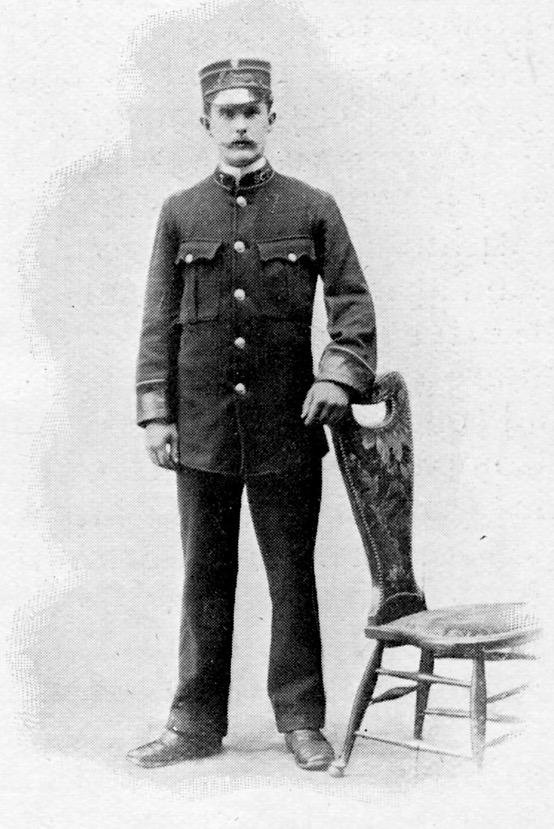
A commercial portrait of Stockport Motorman No 7, though the subject was presumably a model rather than a bona fide employee. The above photograph comes from a short article, presumably paid for by the uniform manufacturers (Messrs Pearson, Huggins and Co, 51 Scrutton St, Finsbury, E.C), in Tramway and Railway World, 1901. Note that the collar initials and employee number are reversed compared to operational photographs. With thanks to David Voice.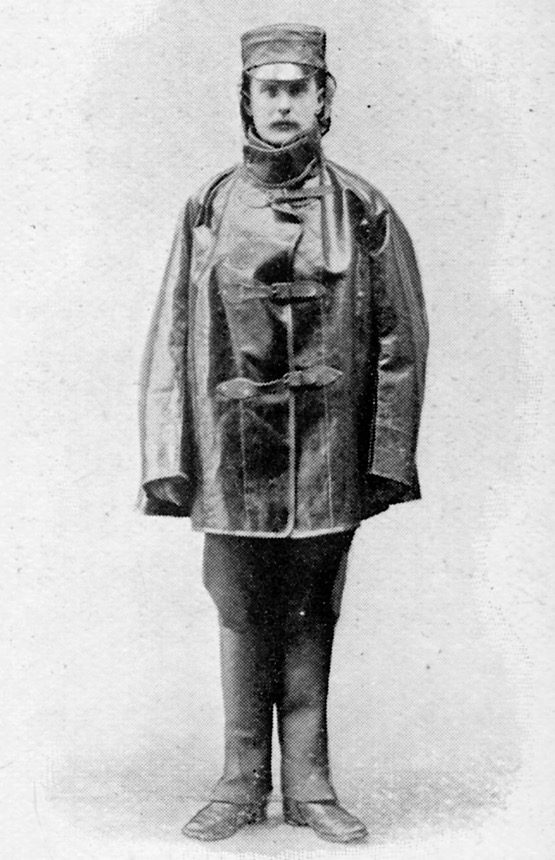
A photograph from the same article as that above, depicting Motorman No 7 in a specially designed oilskin cape. It looks like they expected some inclement weather in Stockport! With thanks to David Voice.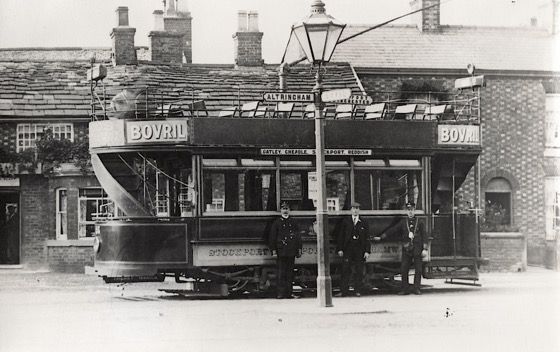
A motorman (left) and his conductor (right) pose in front of Tramcar No 25 outside the Horse and Farrier pub at the Gatley terminus in 1904. Author's Collection.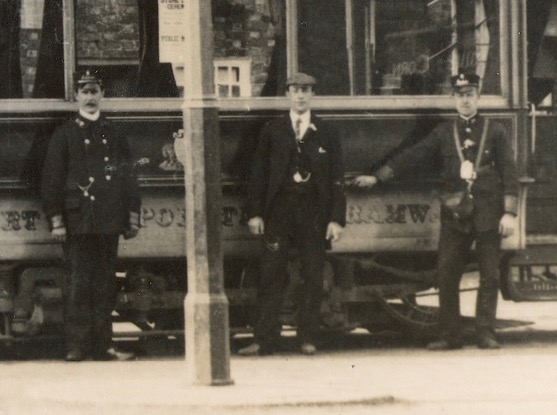
An enlargement of the above photograph showing both the motorman and the conductor, the former in a heavier double-breasted tunic, presumably in recognition of the exposed driving position.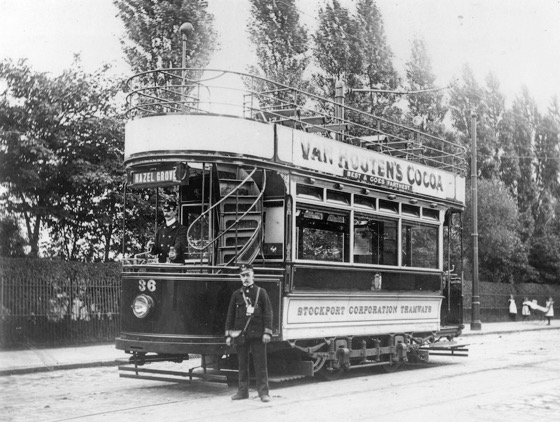
A motorman and a conductor pose for the camera with what appears to be a brand new tramcar, No 36, possibly in Reddish Road — photo undated, but almost certainly taken in 1905. Photo reproduced with the kind permission of the Greater Manchester Transport Society (see link).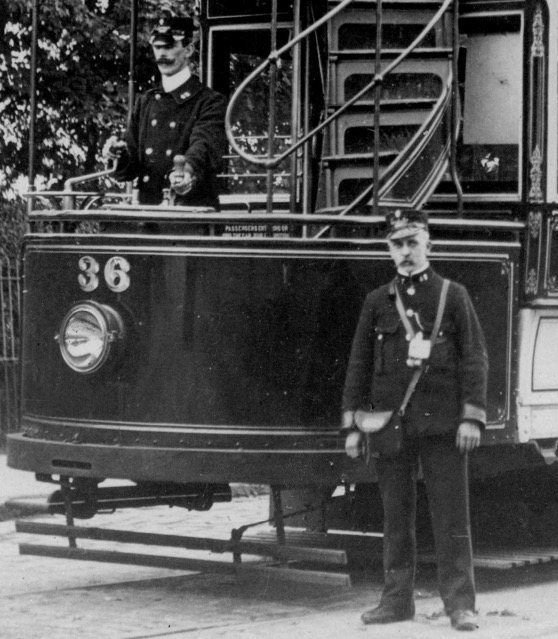
An enlargment of the above photograph showing the motorman and the conductor, both of whom are wearing drooping-peak caps, the former with a 'Motorman' grade badge and the latter with a 'Conductor' grade badge. The conductor is wearing the standard single-breasted jacket with 'S C T' on his right-hand collar and his employee number (possibly '47') on his left-hand collar.
A municipal-device badge of the type used on Stockport Corporation Tramways uniforms — brass. This would have been worn from 1901, though the material would eventually have been changed to nickel, as were the buttons. A subsequent switch to chrome was probably made in the late 1930s or 1940s. Author's Collection.
General pattern script-lettering grade badges of the type used by Stockport Corporation Tramways — brass. These were used on the caps from the opening in 1901, but fell out of use shortly before the Great War. Author's Collection.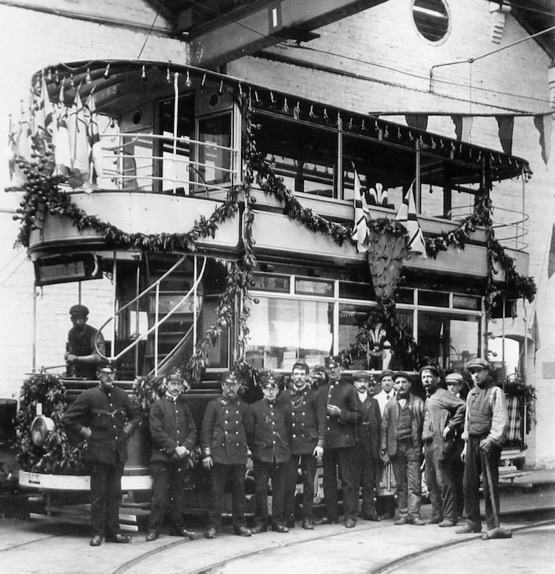
Tramway staff pose alongside a tramcar decorated to mark the visit of their Royal Highnesses, the Prince and Princess of Wales, who were visiting Stockport to open the new Town Hall in 1908. Photo courtesy of the Tramways and Light Railway Society, with thanks to David Voice.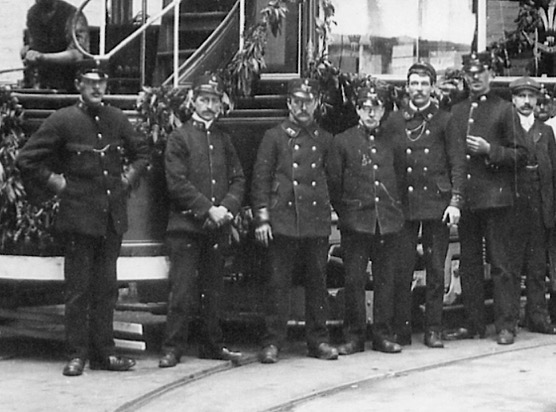
An enlargement of the above photograph showing some of the motormen (in double-breasted jackets) and conductors (in single-breasted jackets). The individual in the centre is wearing the 'SCT' collar badge on his cap rather than the usual script-lettering cap badge. 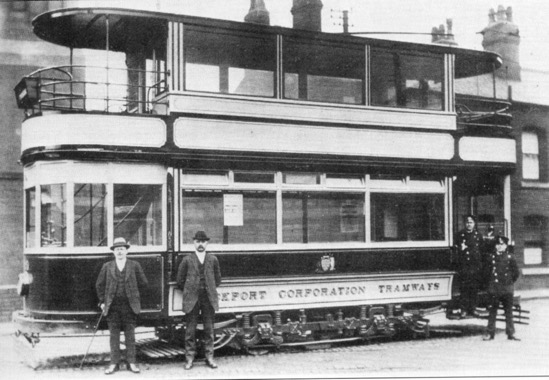
Stockport Corporation Tramways Tramcar No 29, probably in newly outshopped condition, having been vestibuled and top-covered, thus dating the photo to 1922. Both the motorman and conductor are wearing lancer-style tunics and tensioned-crown peaked caps. Photo courtesy of the Tramways and Light Railway Society, with thanks to David Voice.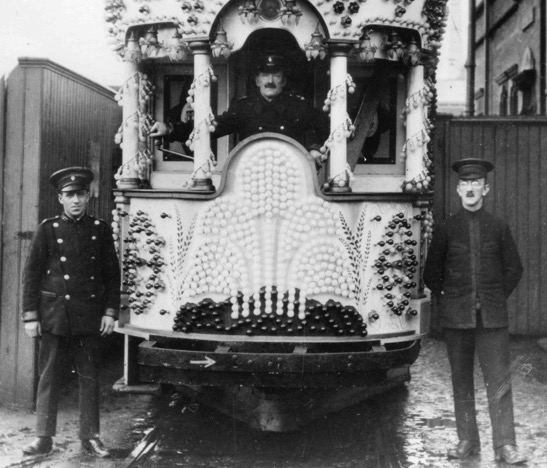
Two tramcar staff and an inspector pose with a decorated tramcar — photo undated, but probably taken in the 1920s or 1930s. The tensioned-crown caps simply bear municipal-device badges, the script-lettering grade badges having fallen out of use by this time. Photo reproduced with the kind permission of the Greater Manchester Transport Society (see link).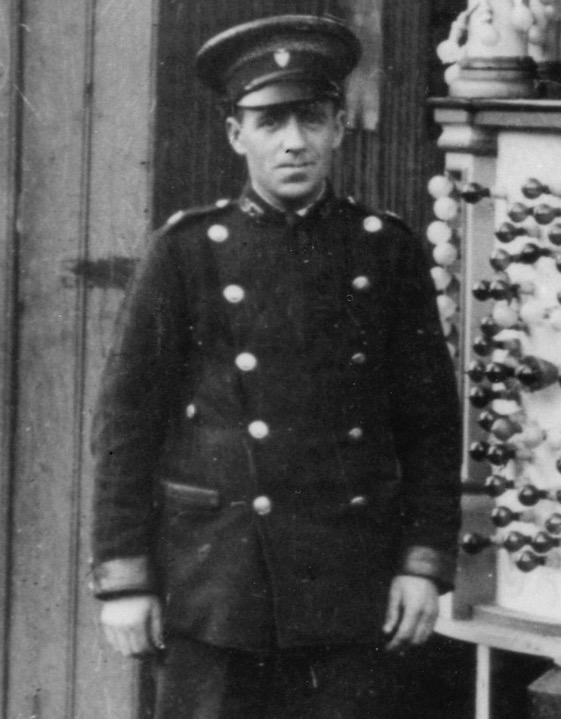
An enlargement of the previous photograph showing the man on the left, in all probability, a conductor. By this time, the system-initials badges on the collar had clearly been changed to a one-piece construction rather than individual initials. Photo reproduced with the kind permission of the Greater Manchester Transport Society (see link).
A Stockport Corporation Tramways system-initials collar badge — brass. It is unclear when these badges first came into use, but possibly as early as 1910. The material would almost certainly have been changed to nickel or chrome at some point, though once again, it is difficult to say when. Author's Collection. 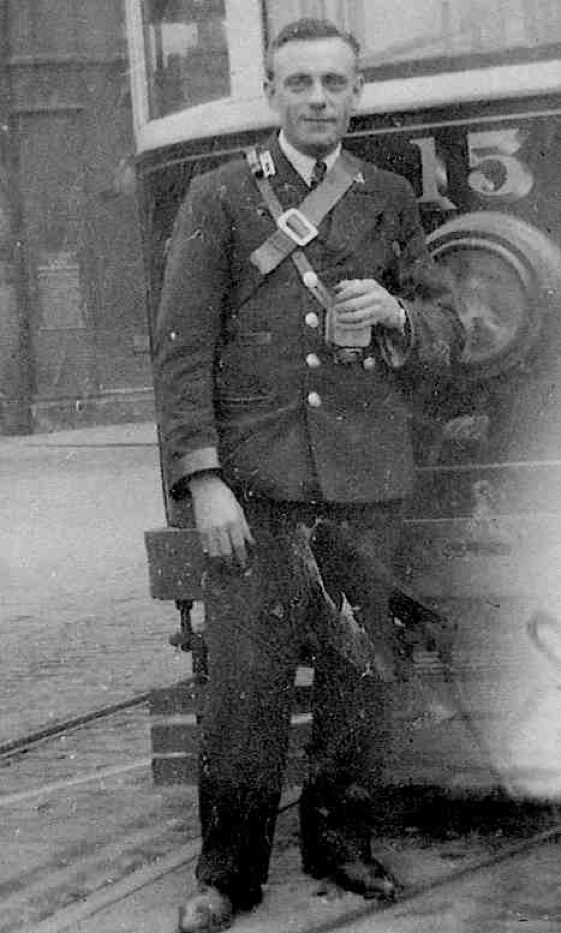
Conductor Tom Lee poses with Tramcar No 15 in Mersey Square in 1938. The one-piece ‘SCT’ lapel badges can be clearly seen, and are now worn on both collars rather than one. Conductor Lee worked on the trams from approximately 1933 to 1939, serving in the armed forces until 1944 when he was wounded. He subsequently returned to Stockport Corporation to work on the buses, eventually moving on to Henry Simons. With thanks to his daughter, Irene Miller.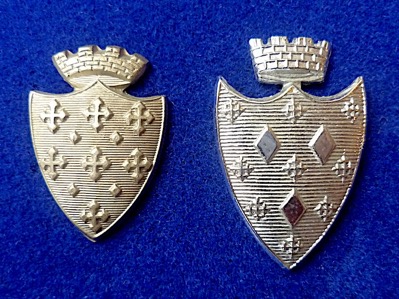
Stockport Corporation municipal-device badges — nickel and chrome. It is highly likely that the badge on the left, which is nickel, superseded the brass equivalent at some point, as nickel Stockport Corporation Electric Tramways buttons have survived. It is unclear whether the larger chrome example on the right was ever worn by tramways staff. Author's Collection.
Senior staff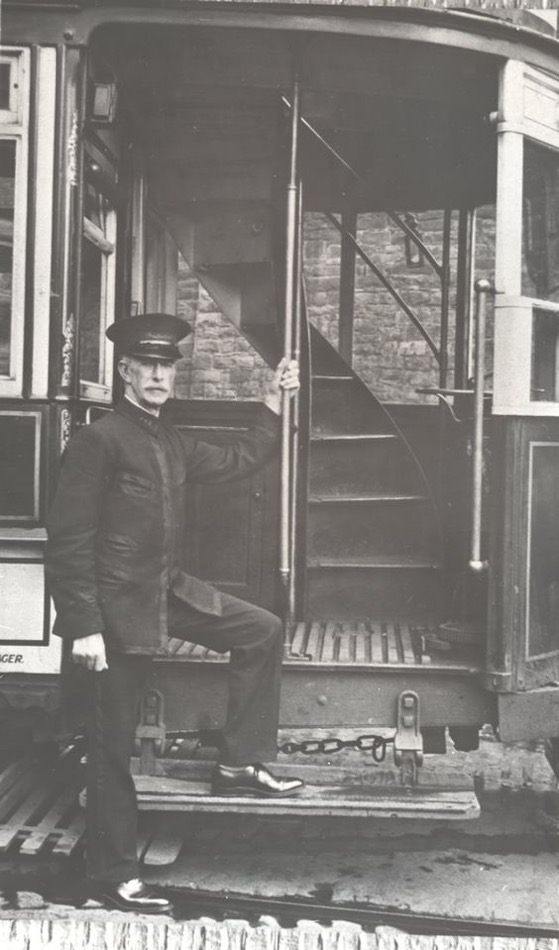
Stockport Corporation Tramways Inspector Arthur Wood (of Heaton Norris) on the platform steps of an unidentified tram — photo believed to have been taken in the Great War. His right-hand collar insignia appear to be embroidered 'S C T' initials. Arthur Wood was a motorman at the time of his marriage in 1904 (aged 33 years), and became an inspector the following year. He died aged 72 years in 1943. With thanks to his great grand-daughter Linzi McNab (nee Wood). Location of original unknown.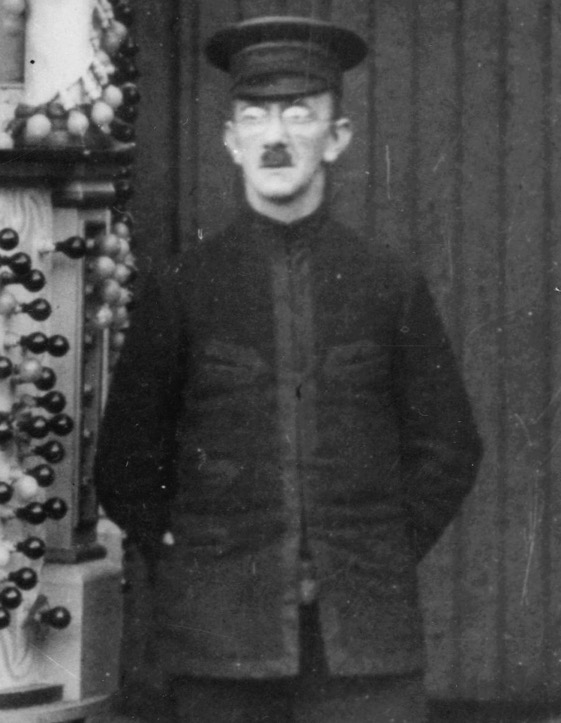
Another blow-up of the decorated tramcar photograph above, this time showing the inspector. Photo reproduced with the kind permission of the Greater Manchester Transport Society (see link).
Female staff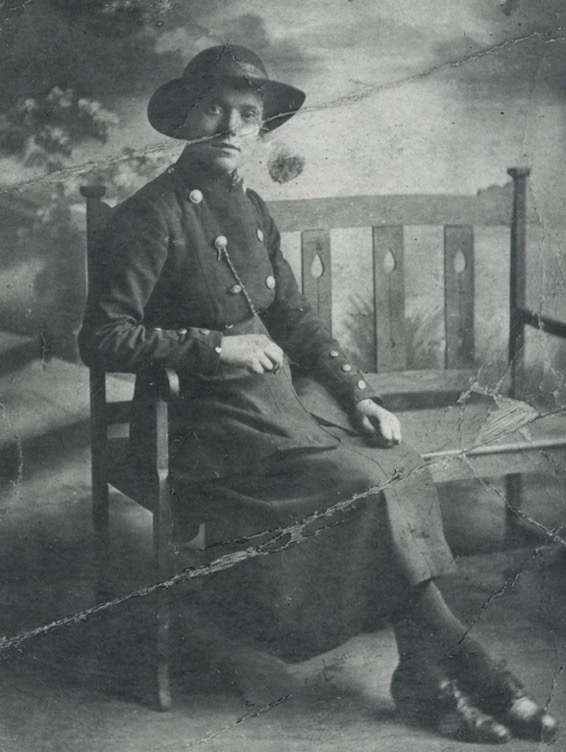
A studio portrait of a Great War Stockport conductress. Source unknown